What is a classic manicure and how to do it?

The European technique of unedged manicure is gaining more and more popularity among women, but despite this, many masters still make classic manicure. The trimming technique effectively solves the problem of a hardened cuticle, which is not so easy to soften at once with a remover, which is why situations often arise when it needs to be cut with scissors or special nippers.





What it is?
A trim manicure is different from all other techniques, and this is evident from its name. So, in European manicure, the cuticle is first softened with special chemical compounds, and then pushed back with an orange stick, while in the classical version, the softened cuticle is cut off using nippers, scissors, scapulae and other metal tools.
Trim manicure means complete removal of the overgrown cuticle from the surface of the nail folds. This procedure involves the obligatory preliminary steaming of rough skin areas in rather warm water, which is why manicure is often called "wet". This treatment prepares the nail plates for decorative or therapeutic coating.
Most often, edged manicure is done on very neglected nails, in its essence it is comparable to SPA procedures, which have the most favorable effect on the cuticle and the surface of the nail.


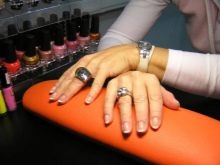
However, this technique also has a drawback - the likelihood of damage to the skin and the risk of infection.Here, strict requirements are imposed on the sterilization of tools and the professionalism of the master, which is why it is best to do such a manicure at home with your own personal tools or contact proven nail service salons. Usually, experts advise starting with a trim manicure, and then, when the cuticle becomes soft, switch to hardware or combined.


Let's dwell on the main features of a classic edged manicure:
- this technique allows you to remove even the most keratinized layers of the epidermis, the overgrown and rough cuticle, which grows very quickly and worsens the general appearance of the nails and hands in general;
- instant effect - this method of processing is optimal for those who need to put their hands in order as quickly as possible;
- after processing, the effect lasts for a rather long time - about a month, during this time, only a decorative coating may require adjustment;
- if you have the necessary tools, you can even make such a manicure at home, and it is quite possible to purchase the tools in any store at a fairly affordable price.



What is the difference from the combined one?
A trim manicure is different from all other types of nail treatments. For example, with hardware manicure, processing is performed with a special device with cutters and other attachments. This device is usually used in beauty salons, since it requires special skills and professional dexterity to work with it. This treatment is suitable for any coatings, including shellac, it takes little time, and the next one will be required no earlier than two months later.
With hardware manicure, it is not necessary to pre-soak the nails and skin areas around theminstead, they are simply smeared with gel and removed with one of the tool's cutters. The treatment lasts very quickly, but the procedure has a significant drawback - due to the fact that the mechanism rotates very quickly, a painful sensation may appear in the nearby nerve endings of the fingers, therefore it is undesirable to purchase such a device for independent use at home.


But edged manicure also has its drawbacks, so some time ago a new technique appeared - a combined manicure, in which several basic procedures are combined. Here, the regrown cuticles, as well as burrs on the lateral ridges, are cut off with tweezers and scissors, then the hardware device is brought to an ideal state: the nail plate is leveled, and the cutter, passing through the cuticle cut, smooths out irregularities and makes the surface smooth.
A combined manicure is considered very effective, because at the first stage it cuts off all rough skin, and then with nozzles processes the cuticle and the rest of the skin around the marigold as efficiently as possible.
The result of the combined manicure is:
- very delicate skin around the nails;
- smooth nail plate;
- complete removal of untidy cuticles and painful burrs.
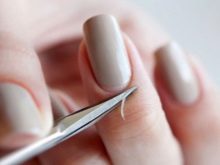


Compared to classic trim manicure:
- the skin on the nail rolls on the sides is smoother;
- there are no cuts;
- in general, the hands look more tidy.



Advantages and disadvantages
Let's dwell on the advantages and disadvantages of a trim manicure.
Compared to other processing methods, it has quite a few advantages.
- Efficiency. The regrown part of the cuticle does not move away, but is cut off, thanks to which the hands remain well-groomed and neat longer.
- Speed of execution. The procedure for performing a classic manicure takes no more than half an hour.
- Versatility. Such processing can be carried out for both women and men; it has practically no contraindications.
- Hand care. Due to the fact that baths with healing infusions and oils are offered before the manicure, their active ingredients have a positive effect on the skin of the hands, making it smoother, fresher and more elastic.Such a manicure is quite often combined with massage, peeling and paraffin therapy.
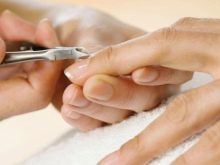


But there are also disadvantages, which are quite significant.
For example, careless use of the tool can damage the skin. In addition to the fact that such cuts in the area of the fingers are quite painful and worsen the general appearance, the main danger is the risk of infection in cases where the sterilization of the working tool, workplace and specialist's hands was not of high quality. When contacting a manicurist, first of all look at the state of his working area, make sure that he opens all the tools in front of you, and ask the specialist to put gloves on his hands.
If these measures are not given due attention, then through a manicure you can infect a person even with such dangerous diseases as hepatitis or HIV. This is the reason why today the overwhelming majority of women in salon conditions prefer hardware processing, and they prefer to do edged manicure at home.

To avoid unpleasant consequences, you should not do a trim manicure if you have:
- inflammatory and dermatological diseases of the nails and skin folds on the sides;
- fungal skin lesions;
- wounds, injuries and cuts;
- poor blood clotting;
- diabetes mellitus.

In all of the above cases, it is better to refuse a trimmed manicure.
So, in case of fungal infections, it is worth giving preference to medical treatment, which not only gives the nails the desired shape, but also heals, and also reduces the risk of transmission of infection to the rest of the master's clients.
In case of skin diseases in the acute stage, it is necessary to wait for the relief of the situation, since such tissues can be injured, which will aggravate the disease and lead to its complications.
And any violation of the integrity of the skin with diabetes mellitus or low blood clotting does pose a threat to the client's life at all, therefore, with such pathologies, you should forget about edged manicure once and for all.

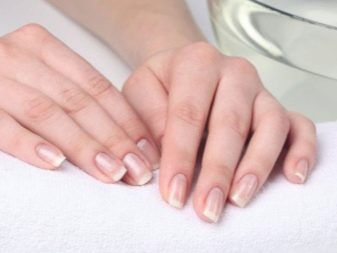
Most experts believe that the cuticle is a kind of barrier that nature has created in order to protect the matrix from bacteria and disruption. Nail service specialists with little experience, in an attempt to remove the stratum corneum of the cuticle, can simply damage the nail plate in the place where it is just starting to grow. This leads to a violation of the smoothness of the nails and causes the appearance of unaesthetic grooves.
In addition, during the bath, the plate absorbs moisture and expands slightly. The decorative coating does not differ in this feature, and cannot adapt to the changing sizes of the nail, all this leads to the fact that the coating quickly rolls off, and the varnish has to be renewed.
Considering all these shortcomings, many abandon the classic manicure, considering this technology outdated.

Varieties
In recent years, more and more often you can find European manicure, the technique of which is similar to the classical one, but at the same time it does not involve the use of cutting tools, which are responsible for the uncut removal of regrown cuticles. In this case, special removers are needed, which are applied to the areas around the marigold. The active ingredients of the composition soften the skin in a few seconds and make it possible to remove it with an orange stick.
Sharp tools are only used here for deburring - such a manicure is considered safer, since it minimizes the risk of infection.
However, this treatment has a very short-term effect, the period of European manicure does not exceed 1 week, in addition, the cuticles must be constantly moistened with special oils to maintain a presentable appearance.



Deluxe manicure is another practice that is used to heal and regenerate the damaged surface of the nail plate. Essentially, the Deluxe is a more sophisticated version of the familiar trim manicure. Before giving the marigold the desired shape and removing the cuticle, the specialist carries out a massage procedure with the obligatory use of paraffin and essential oils, and also includes such care as wrapping, applying masks and serums - all of them prevent the manifestations of age-related changes in the skin of the hands.
Particular attention is paid to the sealing of the marigold, while the plate is exposed to an enhanced effect of vitamins, quartz, manganese and malachite powders. These substances are part of medicinal preparations and strengthen nails, prevent delamination and brittleness. The sealing technique is combined with edging, repeating every 25-30 days.



The classic treatment is also often complemented by a SPA manicure. After the cuticle has been cut off, the expert submits a chemical peel to the skin of the hands in order to polish and finally remove all remaining dead skin particles. As a rule, the result is achieved with formulations based on lactic acids and acupuncture massage, in which the master acts on the energetically active points on the hands, and thereby significantly improves the general condition.


Popular techniques
There are a huge number of different ideas for edged manicure, each of which has its own characteristic features. Let's consider the most popular ones.


French manicure
From a technical point of view, the method of nail processing is no different from the classic edged, but the shade of the decorative coating in this version includes only two primary colors. As a rule, the main part of the nail plate is covered with a pastel shade, and the regrown edge, the so-called smile, is white. This stylish combination of shades always looks very graceful and elegant, while the hands look well-groomed and sophisticated.
However, fashion does not stand still, and nowadays the color scheme can be any, however, it is advisable not to use applying a dark tone to the regrown part of the nail - in this case, the hands give the impression of dirty and untidy.






A related technique, the women's moon manicure, also goes very well with the trimming method for treating the cuticle. This is a classic of style, relevant in any situation. Depending on the selected shades, it can be made in a bright autumnal or summer, sunny way.



Japanese
For this manicure, hardwood tools are used, and only natural preparations. Usually, the master includes in his arsenal of products based on beeswax, as well as bamboo, algae extracts, red tea and pearl powder. To begin with, the nail plate is polished, so the nails acquire the most natural look, then the cuticle is processed, and such a session ends with a massage using bags with medicinal herbs.



American
A feature of such a manicure is the length of the marigold - it should not be less than 1 cm, and the shape is usually given a rounded one. After careful preparation of the nail plate and removal of the cuticle, decorative varnishes are applied, usually in rich and rich shades. Red lacquer looks especially elegant - a combination of luxury and taste. This color will look good on both short and long nails.
To bring such a design to life, it is enough to bring the nails to perfect condition, cover with red varnish, and then top. Additionally, such a manicure can be decorated with rhinestones or a light pattern.


Brazilian
In this version of the classic manicure, hands are undergoing revitalizing treatments that effectively complement standard hand care procedures. After the cuticle is removed, an emollient cream is applied to the hands, then cotton gloves with special impregnation are put on and a massage is performed. As a result, hands acquire a truly impeccable look and amaze with their elegance and well-groomed.



How to do it?
Carrying out a classic manicure involves cutting off coarse nail rollers, which means that in this case the master will need certain tools: tweezers, nail scissors, as well as a pusher, buffs, files, brushes and, of course, a container for steaming.
You will need several files, with varying degrees of abrasiveness. Their rigidity should be selected individually, depending on the characteristics of the nail plate and the expected result. In order to adjust the length, a tool for 200-300 grit will be optimal, and for grinding and polishing, the hardness should be greater - 900-1100 grit.
A little advice: you do not need to buy metal files - they lead to layering of nails and an increase in their fragility.


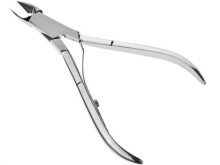
Let's dwell on the step-by-step execution technique. Manicure begins with giving the nails the desired shape, it is selected in each case separately, depending on the shape of the nails and the thickness of the fingers. If a woman has them thin and elongated, then a rectangular shape will look good, but the owners of wide nails can be advised an oval one. Cut off the nails with nippers or scissors, and then file with a file.
If the nails are too long, stratified or broken, then they must be shortened with scissors. In order for the drawing to remain symmetrical, you should focus on the line drawn in the middle of the nail plate from the cuticle to the tip. For filing, it is worth taking special tools on a cardboard or rubber base.
Keep in mind that you need to file dry nails, otherwise, after processing, they will begin to exfoliate.
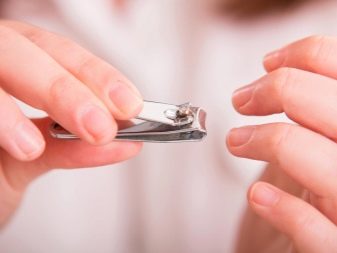

The nails should be filed very carefully so as not to damage the skin. After you get the shape you want, you need to take an orange stick and move the cuticle, and then put your hands in hot soapy water with the addition of nourishing oils and sea salt. This procedure will relax your hands, soothe the skin and soften the keratinized areas of the epidermis for its subsequent cutting.


Traditionally, manicure is done in stages, starting with the left hand, since the right one is usually working, the skin on it is coarser and requires prolonged softening. First, the pushed back cuticle is cut with forceps, doing this very carefully, constantly rinsing with water and wiping with an emollient.
If there are burrs on the hands, then they must be cut off, after having disinfected the nippers. When performing these manipulations, the forceps should adhere to the finger in an almost perpendicular position, but not parallel. The burr should be gently pinched off, it should not be pulled - this can cause sharp painful sensations. The cut site should be treated with hydrogen peroxide or any other disinfectant. Then you need to start processing the nail plate - with the help of a polisher, it is sanded and polished. The polisher is often confused with a nail file, but visually it differs in that it has four working surfaces.



If desired, the treated nails are coated with decorative varnish. First, a base layer is applied, which protects the nail plate from harmful chemical attack, and, in addition, makes the main color coating more saturated and bright. When the base is dry, the base coat should be applied. First of all, the middle of the nail is painted over, and then its edges. If necessary, you can apply a second coat of varnish, after which you need to wait for it to harden. To make the varnish dry faster, you can immerse the nails in a bowl of cool water. Excess varnish is removed with a cotton pad dipped in a special dissolving liquid.
For well-groomed almond-shaped nails, bright glossy and matte shades will be optimal. If there are defects and grooves on the nail plates, do not cover them with pearlescent shades. It is better to cover such nails with dark varnishes that visually lengthen the nail plate or beige.



Useful Tips
In conclusion, let's talk a little about removing burrs and preventing their appearance. Burrs are particles of the epidermis that have peeled off the surface of the nail fold. The reasons for their appearance can be very diverse: dry skin and cuticles caused by the frequent use of household chemicals or improper cutting manicure. They bring great discomfort, and inflammation, irritation, and even abscesses often occur at the cut site.

To minimize the occurrence of burrs, there are a few simple rules to follow.
- All household work should be done exclusively with latex or rubber gloves.
- A trim manicure should only be done with a perfectly sharpened tool.
- The skin around the nail plates should be regularly treated with oils and special agents to soften them.
- It is better to supplement the manicure with a massage of the skin area near the nails, and the procedure should be completed with the application of a nourishing cream. As a result, blood circulation is normalized, and thus the formation of burrs is prevented.




Trim manicure is usually done using regular varnishes that peel off quickly. To prolong the life of such a beautiful coating, you need to follow a few guidelines.
- On the first day after applying the varnish, contact with hot water should be avoided as much as possible: refrain from visiting the sauna and taking a bath.
- Do not file your nails between applications. In this case, the integrity of the manicure will be compromised, the sealed tip of the nail will open and the varnish will begin to flake off.
- To remove the remaining varnish, do not press too hard with a pusher - in this case, the nail plate may deform, and this will cause an uneven coating.
- For hand care, it will be right to give preference to oily-based emollient creams. If you use lighter products, they evaporate almost immediately and do not give the desired effect.
- Every day at night, be sure to lubricate the cuticle with special oils, this will improve blood circulation to the skin near the nail, and prevent premature growth of the lateral ridges.


For information on how to do a classic manicure, see the next video.








